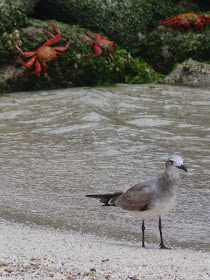Little Española, in the far south-east of the Galápagos archipelago, is among the oldest of the islands (other than those that are already submerged, further to the east), eroding away into the sea. The whole archipelago of exposed volcanic peaks is riding the Nazca Plate towards South America; the youngest islands are the western ones, still passing over the 'hot spot' where fiercely hot magma is close to the crust's surface. Española's days (or millenia) may be numbered, but meantime it is one of the most exciting place for wildlife in the whole of the Galápagos, which is saying a very great deal!
 |
| The location of Española is indicated by the red arrow; the volcanic 'hot spot' is currently under Isabela and Fernandina to the west, and the whole archipelago is sailing east with the Nazca Plate. |
There is so much to say about Española that I won't attempt to do so in one posting; it is probably most famous for seabirds, so let's start today with them. The Waved Albatross Phoebastria irrorata is the world's only tropical albatross and virtually the entire world population breeds on Española (there are a few breeding pairs on Isla de la Plata off the coast of central Ecuador). This is no coincidence; albatrosses rely on the wind (which is why nearly all species live in the permanently howling winds of the far southern oceans), and find it virtually impossible to take off from flat ground, because of their weight and hugely long wings. Only on Española is there flat ground for breeding alongside cliffs that face the prevailing winds for takeoff. When the winds fail in January and February they move closer to the mainland to fish.
The walking track - to which it is compulsory to keep - runs near the edge of the colony, but not close enough to nesting sites to cause problems. It is a remarkable experience to watch the great birds displaying to reinforce pair bonds, and to encounter the huge calm curious chicks, shabby as they moult into adult plumage.
 |
| Waved Albatross colony, Española. |
 |
| They are a beautiful and imposing bird seen close up. |
 |
| Courtship, above and below, involves exaggerated stepping, sky-pointing, mellow honking and loud beak slapping, like children sword-fighting. |
 |
| It requires some imagination to see the cheerful buffoonish chicks as the infinitely graceful adults they will soon become. |
 |
| To watch them lumber into the wind, or simply drop over the cliff edge, then soar overhead or even below us along the cliff, is nothing less than thrilling. |
 |
| And finally, if you were wondering about the 'Waved' part of the name, here's the answer, in the delicate filigree pattern on neck, breast and flanks. |
But when you can finally tear yourself away from the albatross colony there are other special seabirds to admire from close range too, including two species of booby. These lovely tropical gannets have been known as boobies in English for over 400 years; it is apparently derived from Spanish bobo, a fool, based on their trusting habits which enabled sailors to slaughter them with ease at breeding colonies. We really are shockers at times! Blue-footed Boobies are the ones most readily encountered throughout the Galápagos, though they are actually the least abundant of the three species - the other two however breed only on remote islands, so are less evident to most visitors. I can't ever imagine not stopping to admire the Blue-foots though!
 |
| Blue-footed Booby Sula nebouxii, Española. The egg is just visible under the breast. |
And fortunately Española is one of those remote islands, and supports a healthy breeding colony of Nazca Booby Sula granti. This is a primarily Galápagos species, formerly regarded as a sub-species of the more widespread Masked Booby Sula dactylatra.
 |
| Nazca Booby colony on plateau, Española. They are bigger birds than the Blue-foots, and like the albatrosses appreciate the advantages of cliff-top takeoffs. |
 |
| Nazca Booby pair. |
 |
| Nazca Booby with eggs, Española. They nearly always lay two but, as in some other bird species, the second chick is just insurance, and if its older sibling survives, it will not. |
Gulls are also present, both visitors and permanent residents.
 |
| Franklin's Gull Leucophaeus pipixcan, a non-breeding migrant from North America. And what an excellent place to avoid the northern winter! (Sally Lightfoot Crabs in the background.) |
There is much more to tell you about Española however, and next time, more birds, plus mammals and reptiles!
BACK ON TUESDAY


If you are not getting a spotters fee from the Galapagos Tourist Board you should be! Magnificent.
ReplyDeleteMartin